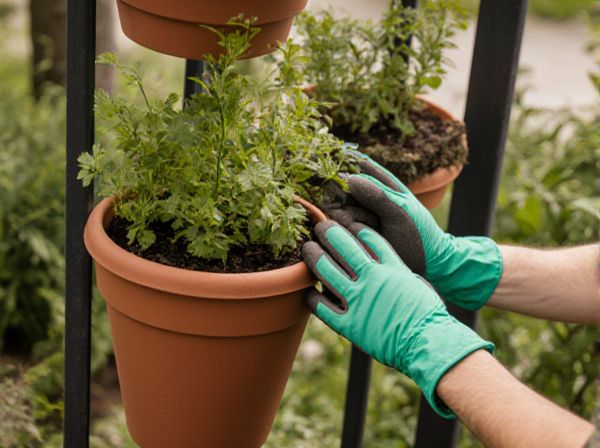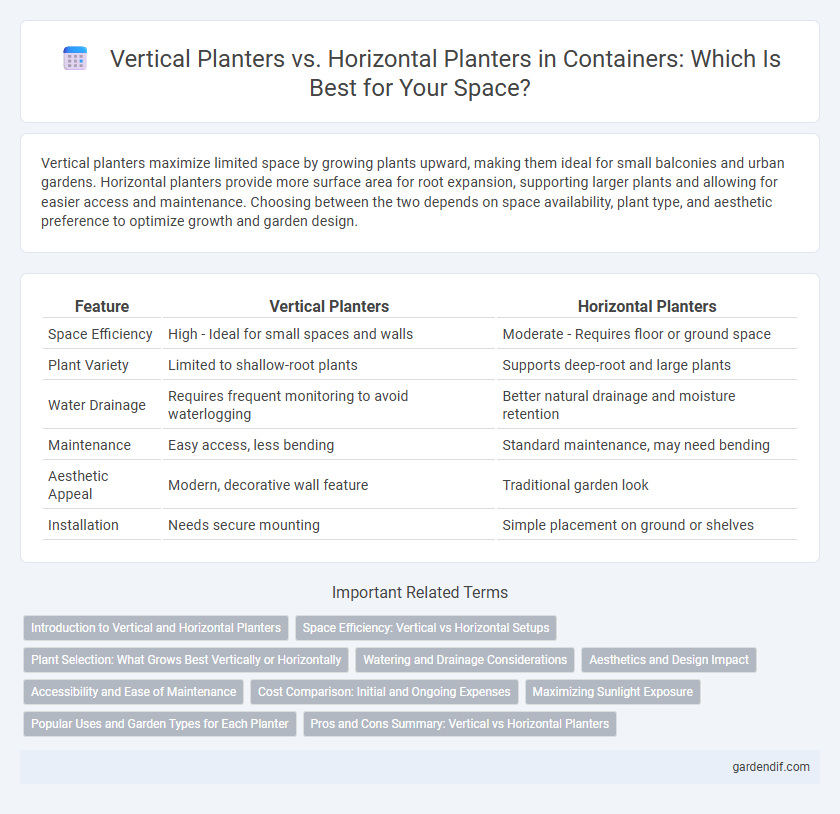
Vertical planters vs horizontal planters Illustration
Vertical planters maximize limited space by growing plants upward, making them ideal for small balconies and urban gardens. Horizontal planters provide more surface area for root expansion, supporting larger plants and allowing for easier access and maintenance. Choosing between the two depends on space availability, plant type, and aesthetic preference to optimize growth and garden design.
Table of Comparison
| Feature | Vertical Planters | Horizontal Planters |
|---|---|---|
| Space Efficiency | High - Ideal for small spaces and walls | Moderate - Requires floor or ground space |
| Plant Variety | Limited to shallow-root plants | Supports deep-root and large plants |
| Water Drainage | Requires frequent monitoring to avoid waterlogging | Better natural drainage and moisture retention |
| Maintenance | Easy access, less bending | Standard maintenance, may need bending |
| Aesthetic Appeal | Modern, decorative wall feature | Traditional garden look |
| Installation | Needs secure mounting | Simple placement on ground or shelves |
Introduction to Vertical and Horizontal Planters
Vertical planters maximize limited space by growing plants upward on walls or towers, ideal for small balconies and urban gardens. Horizontal planters spread plants across a flat surface, providing ample room for root development and easier access for watering and maintenance. Choosing between vertical and horizontal planters depends on available space, plant type, and aesthetic preferences.
Space Efficiency: Vertical vs Horizontal Setups
Vertical planters maximize space efficiency by utilizing upward growth, ideal for small balconies or urban gardens where floor area is limited. Horizontal planters require more surface area but offer easier access for planting and maintenance. Choosing between vertical and horizontal setups depends on available space, plant types, and user convenience preferences.
Plant Selection: What Grows Best Vertically or Horizontally
Vertical planters optimize space for climbing plants like beans, peas, cucumbers, and certain vine tomatoes, which thrive when supported upward. Horizontal planters suit root vegetables, sprawling herbs, and leafy greens such as lettuce, spinach, and kale that require more surface area for growth. Choosing the right planter orientation depends on plant growth habits, ensuring optimal light exposure and nutrient access for maximum yield.
Watering and Drainage Considerations
Vertical planters require careful watering management to ensure even moisture distribution across all levels, preventing water from pooling at the bottom and causing root rot. Horizontal planters generally allow more consistent drainage due to their flat orientation, reducing the risk of waterlogging but demanding thorough initial drainage hole placement. Proper soil selection and drainage layer integration are critical in both planter types to maintain optimal plant health and prevent overwatering issues.
Aesthetics and Design Impact
Vertical planters maximize space while creating a striking visual statement by drawing the eye upward, ideal for small areas or accent walls. Horizontal planters offer a more traditional, expansive layout that enhances garden beds and balconies with a seamless, natural flow. Both designs impact aesthetics differently, with vertical styles emphasizing modernity and sculptural form, and horizontal styles promoting lushness and grounded harmony.
Accessibility and Ease of Maintenance
Vertical planters offer superior accessibility by allowing plants to be reached at various heights without bending, which reduces strain during planting and harvesting. Horizontal planters require more frequent bending and kneeling, making maintenance tasks such as watering and pruning more physically demanding. The vertical arrangement also enhances ease of maintenance by improving air circulation and sunlight exposure, reducing disease risk compared to crowded horizontal setups.
Cost Comparison: Initial and Ongoing Expenses
Vertical planters typically require higher initial costs due to complex structures and materials like PVC or metal frames, whereas horizontal planters are generally more affordable with simpler trays or beds. Ongoing expenses for vertical systems can increase because of specialized irrigation and maintenance needs, while horizontal planters usually incur lower water and upkeep costs. Evaluating budget constraints and long-term maintenance is crucial for selecting between vertical and horizontal container gardening solutions.
Maximizing Sunlight Exposure
Vertical planters optimize sunlight exposure by allowing plants to grow upward, reducing shading and maximizing surface area exposed to light. Horizontal planters may limit sunlight access as plants spread laterally, creating shadows and competition for light. Choosing vertical configurations enhances photosynthesis efficiency and promotes healthier plant growth in confined spaces.
Popular Uses and Garden Types for Each Planter
Vertical planters are popular for urban gardens, balconies, and small spaces, ideal for growing herbs, succulents, and climbing plants in container gardens or living walls. Horizontal planters suit traditional garden beds, patios, and raised garden boxes, supporting a wide range of vegetables, flowers, and ground-cover plants. Vertical planters optimize vertical space in container gardening, while horizontal planters provide extensive root area for diverse plant types.
Pros and Cons Summary: Vertical vs Horizontal Planters
Vertical planters optimize limited space by allowing plants to grow upward, improving air circulation and reducing soil-borne diseases, but may face challenges with uneven water distribution and root crowding. Horizontal planters provide better root expansion and easier access for maintenance, supporting larger plant varieties, yet they consume more ground space and may increase exposure to pests. Choosing between vertical and horizontal planters depends on space availability, plant types, and maintenance preferences.
Vertical planters vs horizontal planters Infographic

 gardendif.com
gardendif.com